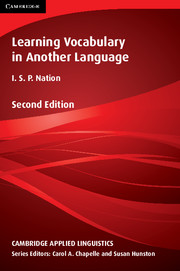Book contents
- Frontmatter
- Contents
- Series editors' preface
- Acknowledgements
- Introduction
- 1 The goals of vocabulary learning
- 2 Knowing a word
- 3 Teaching and explaining vocabulary
- 4 Vocabulary and listening and speaking
- 5 Vocabulary and reading and writing
- 6 Specialised uses of vocabulary
- 7 Vocabulary-learning strategies
- 8 Learning words from context
- 9 Word parts
- 10 Using dictionaries
- 11 Deliberate learning from word cards
- 12 Finding and learning multiword units
- 13 Testing vocabulary knowledge and use
- 14 Designing the vocabulary component of a language course
- Appendices
- Subject index
- Author index
Series editors' preface
Published online by Cambridge University Press: 15 February 2018
- Frontmatter
- Contents
- Series editors' preface
- Acknowledgements
- Introduction
- 1 The goals of vocabulary learning
- 2 Knowing a word
- 3 Teaching and explaining vocabulary
- 4 Vocabulary and listening and speaking
- 5 Vocabulary and reading and writing
- 6 Specialised uses of vocabulary
- 7 Vocabulary-learning strategies
- 8 Learning words from context
- 9 Word parts
- 10 Using dictionaries
- 11 Deliberate learning from word cards
- 12 Finding and learning multiword units
- 13 Testing vocabulary knowledge and use
- 14 Designing the vocabulary component of a language course
- Appendices
- Subject index
- Author index
Summary
Over ten years ago, when the first edition of Learning Vocabulary in Another Language was published, vocabulary learning was characterised by the then series editors as an area studied by only a few pioneers, Paul Nation being one of them. In part due to the tremendous impact of the first edition of Nation's book, today research and teaching of second language vocabulary learning is no longer the preoccupation of just a few. On the contrary, throughout applied linguistics, vocabulary, formulaic expressions, word patterns and lexical bundles are centre stage in the study of how learners develop the ability to make meaning. With the importance of the lexical dimension of language development recognised, the research basis for understanding vocabulary teaching and learning has grown to be substantial. A second edition of Paul Nation's seminal work was needed.
The second edition of Learning Vocabulary in Another Language possesses the same qualities that made the first edition so popular. It is organised around issues relevant to readers needing a solid understanding of vocabulary in order to improve practices in second language vocabulary teaching and assessment. For example, chapters outline the goals of vocabulary learning, teaching and explaining vocabulary, vocabulary and listening and speaking, as well as vocabulary and reading. The book presents and interprets a comprehensive pool of research on second language vocabulary acquisition, and in so doing it provides research-based recommendations for practice.
- Type
- Chapter
- Information
- Learning Vocabulary in Another Language , pp. xiiiPublisher: Cambridge University PressPrint publication year: 2013



